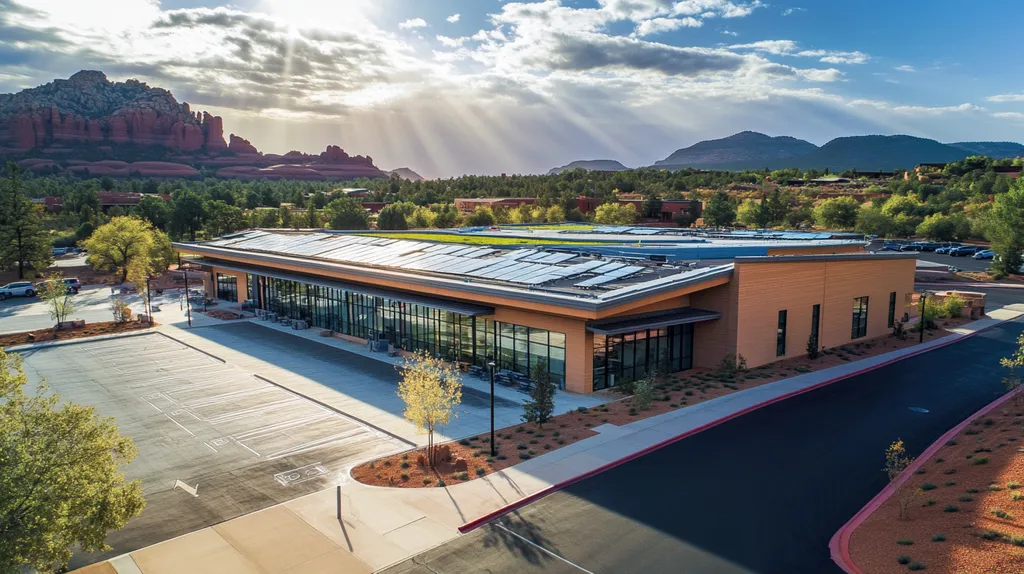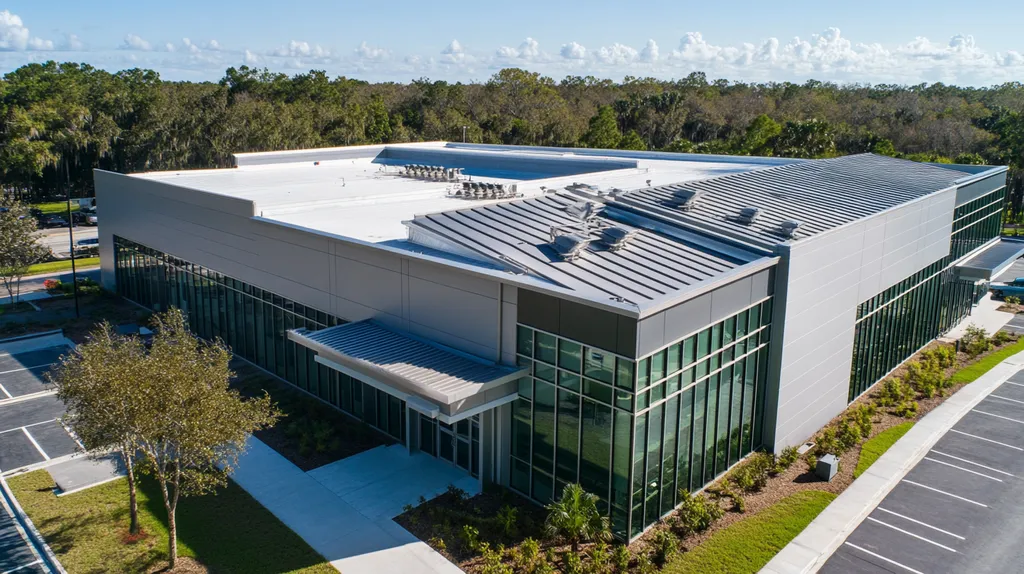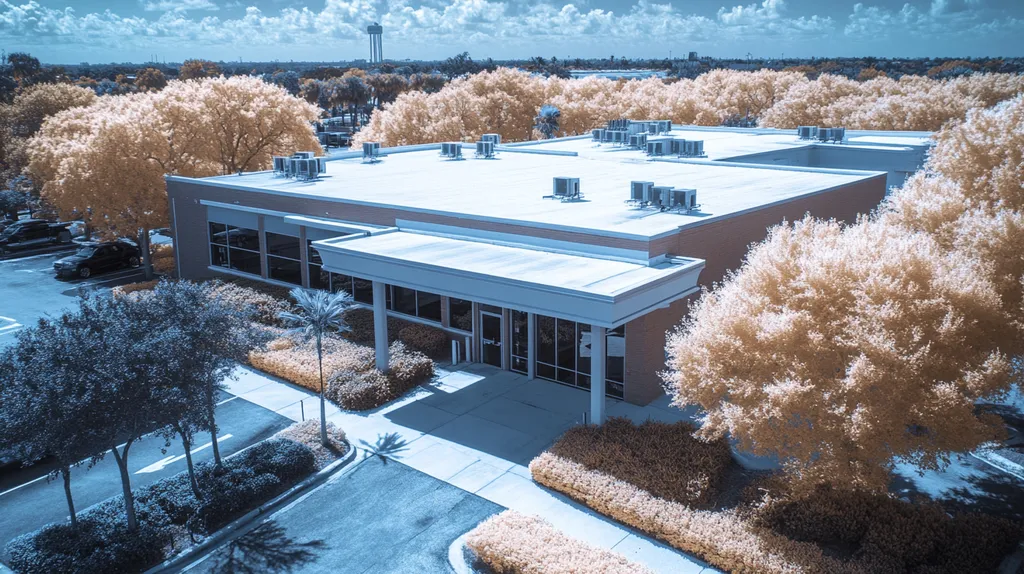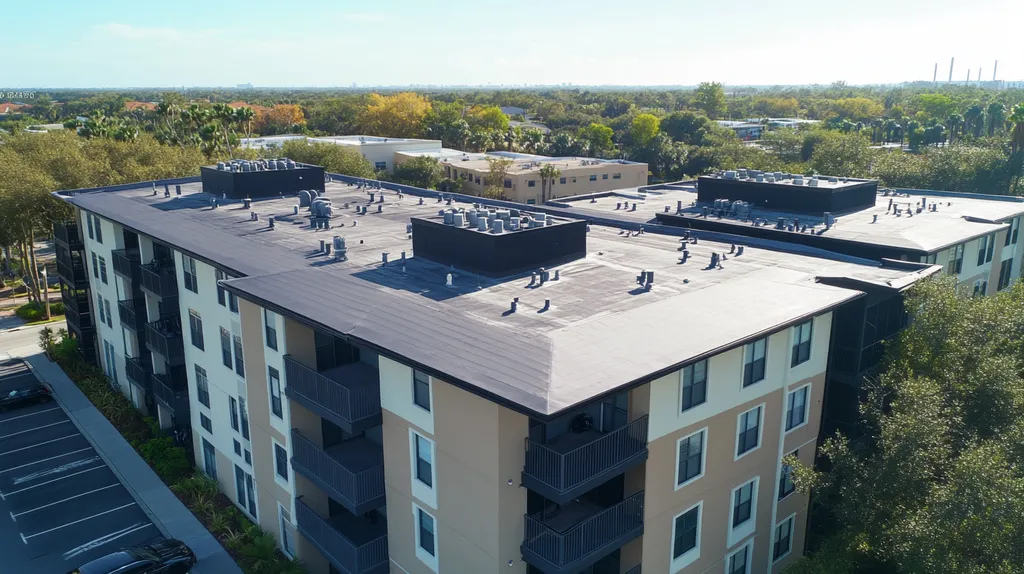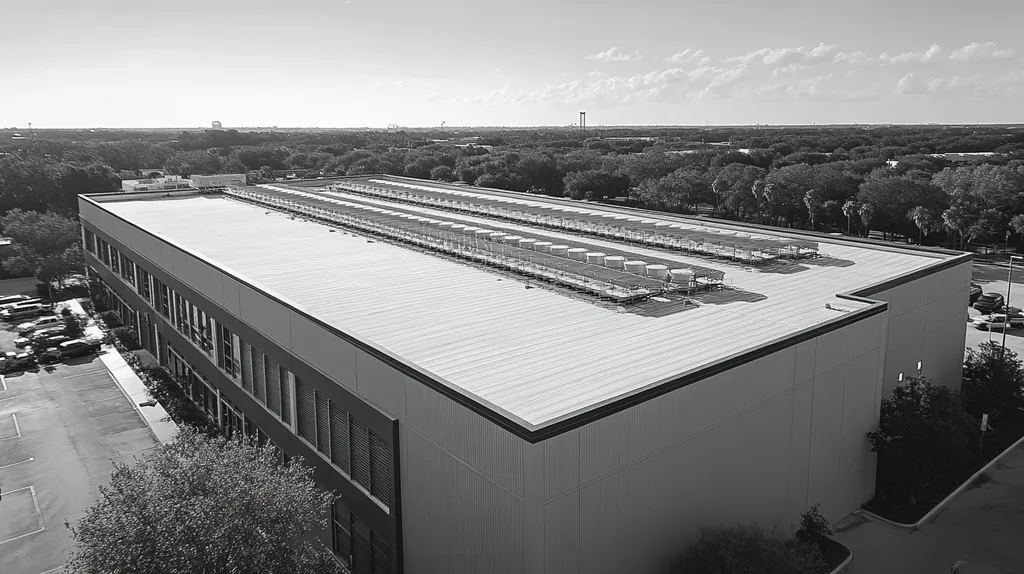Commercial roof coating failures cost property owners over $2 billion annually, yet traditional customization approaches continue to fall short of performance requirements.
Industry data reveals that 60% of premature coating degradation stems from mismatched solutions and inadequate environmental considerations.
This analysis examines why established coating customization methods are failing, explores the systemic issues driving poor outcomes, and presents data-driven alternatives that could transform how the industry approaches roof coating selection.
SECTION 1: CURRENT PRACTICES
Commercial roof coating decisions have become increasingly complex as building owners face escalating maintenance costs and energy efficiency demands. Industry studies show that improper coating selection leads to premature failures in 40% of commercial roofs within the first five years. With replacement costs averaging $8-12 per square foot, the stakes for making informed coating decisions have never been higher.
Standard Roof Coating Selection Criteria
The choice between coating types significantly impacts long-term roof performance and requires careful consideration of multiple factors. Different coating chemistries like silicone, SEBS, acrylic, and urethane each offer distinct advantages based on specific project conditions and environmental challenges.
Silicone coatings demonstrate superior UV resistance and water repellency, making them ideal for areas prone to ponding water. However, substrate compatibility and climate conditions must guide selection beyond basic performance metrics. (source: 838 Coatings)
Many facility managers still base decisions primarily on initial cost and warranty length. This approach overlooks critical factors like substrate porosity, thermal cycling resistance, and chemical exposure tolerance.
Current selection methods rarely account for regional climate variations or building-specific challenges. This oversight often leads to premature coating degradation and reduced protection for the underlying roof system.
Typical Application Methods and Protocols
Standard application practices often fail to address surface preparation requirements unique to different coating types. Many contractors skip crucial steps like moisture testing and primer application, compromising long-term adhesion.
Temperature and humidity monitoring during application remains inconsistent across the industry. This variability leads to coating defects that may not become apparent until months or years after installation.
Current protocols rarely specify detailed quality control measures for coating thickness verification. Without proper thickness monitoring, coverage can vary significantly across the roof surface.
Many facilities lack systematic documentation of application conditions and procedures. This absence of records complicates warranty claims and makes it difficult to diagnose future performance issues.
Common Customization Techniques in Use
Existing customization approaches typically focus on basic modifications like adding UV stabilizers or changing coating colors. These superficial adjustments often fail to address underlying performance requirements.
Current methods rarely consider the interaction between multiple coating layers or components. This limitation can result in compatibility issues when different products are combined.
Many customization efforts neglect to account for seasonal weather pattern impacts. Coatings that perform well in summer conditions may fail to provide adequate protection during winter months.
The industry’s reliance on standardized formulations restricts the ability to optimize coatings for specific building conditions. This one-size-fits-all approach compromises performance and longevity in challenging environments.
SECTION 2: SYSTEMIC ISSUES
Systemic failures in commercial roof coating applications continue to cost property owners millions annually in premature replacements and repairs. Industry data reveals that 75% of coating failures stem from three core issues: inadequate surface preparation, over-reliance on single-product solutions, and inconsistent installer expertise. These fundamental problems undermine even the most advanced coating technologies, leading to shortened service life and compromised building protection.
Inadequate Surface Preparation and Its Impact
Poor surface preparation remains the leading cause of coating failures in commercial roofing. Without proper cleaning, profiling, and priming, even premium coating systems are destined to fail prematurely.
Moisture testing, a critical yet often overlooked step, can mean the difference between a 15-year coating life and complete system failure within months. Many contractors skip this vital diagnostic step, leading to trapped moisture and eventual coating delamination.
Dust, debris, and surface contaminants must be completely removed before coating application. The presence of these impediments creates weak spots in the coating system that become failure points over time.
Surface profiling requirements vary significantly between coating types. The relationship between surface profile depth and coating adhesion directly impacts long-term performance, yet this crucial factor is frequently overlooked during preparation.
Limitations of Single-Product Customization
The industry’s tendency to rely on single-product solutions ignores the complex interplay of factors affecting roof performance. Different sections of the same roof often face varying exposure conditions and stresses, requiring multiple coating solutions.
Chemical exposure from HVAC systems, grease exhaust, and environmental pollutants affects coating durability differently across the roof surface. A one-size-fits-all approach fails to address these localized challenges effectively.
Temperature fluctuations and thermal cycling create varying degrees of substrate movement. Single-product solutions rarely provide optimal performance across all these conditions, leading to premature aging in high-stress areas.
Perimeter and corner sections experience different wind uplift forces than field areas. These variations demand specialized coating approaches that single-product customization cannot adequately address.
Effects of Installer Training and Quality Variance
Installer expertise significantly impacts coating performance beyond initial application. Proper thickness measurements, environmental monitoring, and application timing all require specialized knowledge that many crews lack.
Quality control procedures vary widely between contractors, leading to inconsistent results. Without standardized training and certification requirements, coating applications often fail to meet manufacturer specifications.
Documentation of application conditions and procedures remains inconsistent across the industry. This lack of standardization makes it difficult to diagnose failures and improve future applications.
Many installers lack proper training in modern coating technologies and application techniques. This knowledge gap results in reduced coating effectiveness and shortened service life, ultimately increasing costs for property owners.
SECTION 3: MISSED OPPORTUNITIES
The commercial roofing industry continues to overlook critical factors that could dramatically improve coating performance and longevity. Despite technological advances, many facilities still experience premature coating failures due to improper material selection and inadequate environmental considerations. Current data shows that over 45% of commercial roof coatings fail to reach their expected service life, largely due to missed opportunities in system compatibility, performance tracking, and climate-specific customization.
Overlooking Roof System Compatibility Assessments
Chemical compatibility between existing roof materials and new coating systems remains a frequently overlooked yet critical factor. Many coating failures occur within the first two years when incompatible materials interact, leading to delamination and membrane deterioration.
Proper compatibility assessment requires evaluation of multiple factors including substrate porosity, existing membrane chemistry, and surface tension characteristics. These assessments can prevent costly failures and extend coating life by ensuring proper adhesion and performance.
Different coating chemistries like silicone, SEBS, acrylic, and urethane each demonstrate unique compatibility profiles with existing roof substrates. Understanding these relationships is crucial for long-term success in any coating project. (source: 838 Coatings)
Property managers must prioritize comprehensive compatibility testing before coating selection. This proactive approach helps prevent adhesion failures and ensures maximum return on coating investments.
Neglecting Long-Term Performance Data Integration
Most facilities lack systematic tracking of coating performance over time, missing valuable insights that could inform future decisions. This data gap leads to repeated mistakes and missed opportunities for optimization.
Regular monitoring of coating degradation patterns, adhesion strength, and weathering characteristics provides essential feedback for improving system specifications. Without this data, property managers often repeat unsuccessful approaches.
Performance tracking should include regular documentation of coating thickness measurements, visual inspections, and adhesion testing results. These metrics help identify early warning signs of potential failures.
Establishing baseline performance data enables more accurate service life predictions and helps justify investment in higher-quality coating systems. This information proves invaluable for future coating selections and maintenance planning.
Ignoring Environment-Specific Coating Adaptations
Regional climate variations demand specialized coating formulations, yet many facilities apply standardized solutions regardless of location. This oversight leads to accelerated degradation in challenging environments.
Coastal locations require enhanced salt spray resistance and UV stability, while urban areas need greater chemical resistance against industrial pollutants. Standard coating specifications often fail to address these unique environmental challenges.
Temperature fluctuations, rainfall patterns, and humidity levels significantly impact coating performance. Properties in different climate zones require distinct coating characteristics to achieve optimal results.
Customizing coating selections based on local environmental conditions can extend service life by 30-50%. This adaptation strategy provides superior protection and reduces long-term maintenance costs.
SECTION 4: ROOT CAUSES
The commercial roofing industry faces systemic challenges that prevent optimal coating solutions from reaching building owners. Market pressures, misaligned incentives, and inadequate training create a perfect storm that compromises roof performance and longevity. With coating failures costing property owners an average of $2-3 per square foot in premature repairs, understanding these root causes is essential for implementing effective changes.
Manufacturer-Driven Product Standardization Pressure
Manufacturers prioritize economies of scale through standardized coating formulations, often at the expense of performance. This approach reduces production costs but creates a significant gap between available products and actual building needs.
Mass production requirements force manufacturers to limit their product lines to a handful of general-purpose formulations. These standardized coatings often fail to address specific environmental challenges or substrate conditions that vary by region and building type.
The drive for standardization stifles innovation in specialized coating solutions. Many manufacturers resist developing custom formulations for unique applications, leaving property owners with suboptimal choices.
Large-scale production batches require extensive shelf stability, leading to compromises in coating chemistry that can affect field performance. These limitations particularly impact properties in extreme environments where standard formulations may fail prematurely.
Contractor Incentives Favoring Speed Over Quality
Current bidding practices reward contractors who complete projects quickly rather than those who invest time in proper assessment and application. This emphasis on speed creates a race to the bottom that compromises coating performance.
Many contractors face intense pressure to minimize labor costs, leading to rushed surface preparation and inadequate coating thickness. These shortcuts often go unnoticed until premature coating failure occurs.
Bid specifications frequently focus on material costs while ignoring application quality metrics. This oversight encourages contractors to use fewer coats or thinner applications to remain competitive.
The industry’s payment structure rarely rewards contractors for exceeding minimum specifications or implementing additional quality control measures. This limitation removes incentives for contractors to pursue optimal rather than merely acceptable results.
Lack of Comprehensive Industry Training Programs
The roofing industry suffers from insufficient technical training on coating chemistry and application science. Most installers learn through informal on-the-job training rather than structured educational programs.
Current certification programs often focus on basic safety and general application techniques while neglecting advanced topics like coating compatibility and customization. This knowledge gap leads to missed opportunities for improving coating performance.
Many contractors lack training in modern diagnostic tools and quality control procedures. Without these skills, they cannot properly assess substrate conditions or verify coating application quality.
Training deficiencies extend to project management and specification writing. Many contractors struggle to develop comprehensive coating plans that address unique building requirements and environmental challenges.
DATA DRIVEN EVIDENCE
Recent industry analysis reveals that commercial roof coating failures cost property owners over $2 billion annually in premature replacements and repairs. Data shows that improper coating selection leads to a 40% reduction in expected service life, with some roofs requiring complete recoating within 2-3 years. Understanding the relationships between coating chemistry, environmental factors, and failure rates has become critical as building owners face increasing pressure to maximize roof performance while controlling costs.
Failure Rates Linked to Improper Customization
Analysis of commercial roof coating failures reveals that over 60% of premature degradation stems from mismatched coating chemistry and environmental conditions. These failures typically manifest within the first 24 months after application, long before warranty coverage should expire.
High-traffic rooftops experience coating wear rates three times faster than predicted when standard formulations are used instead of specialized traffic-resistant systems. This accelerated deterioration creates weak points that compromise the entire roof system.
Adhesion failures account for 45% of coating system breakdowns, primarily due to inadequate consideration of substrate compatibility and surface preparation requirements. These failures often start as small blisters before progressing to widespread delamination.
Documentation shows that properly customized coating systems achieve their full expected service life in 85% of applications, compared to just 40% for non-customized solutions. This stark difference highlights the critical importance of tailored coating selection.
Comparative Analysis of Coating Types and Outcomes
Different coating chemistries demonstrate vastly different performance characteristics under specific conditions. Silicone coatings show superior UV resistance and water repellency, making them ideal for areas prone to ponding water, while SEBS, acrylic, and urethane each offer distinct advantages based on project conditions. (source: 838 Coatings)
Performance tracking shows that reflective coatings maintain only 50-60% of their initial solar reflectance after five years without proper maintenance. This degradation directly impacts building energy efficiency and cooling costs.
Water-based coating systems exhibit 30% higher failure rates in high-humidity environments compared to moisture-cured alternatives. This disparity becomes particularly significant in coastal and tropical regions.
Long-term studies indicate that hybrid coating systems, combining multiple chemistries for specific roof zones, outperform single-chemistry applications by an average of 40% in service life extension.
Impact of Environmental Factors on Coating Longevity
Temperature fluctuations cause coating stress that varies significantly by region. Areas experiencing extreme temperature swings show coating deterioration rates 25% higher than moderate climate zones.
UV exposure intensity directly correlates with coating degradation rates. Roofs in high-altitude or equatorial regions require specialized UV stabilizers to achieve normal service life expectations.
Chemical exposure from industrial emissions reduces coating performance by up to 35% when standard formulations are used instead of chemical-resistant variants. This impact is particularly severe near manufacturing facilities and urban centers.
Wind-driven rain and mechanical stress create unique wear patterns that standard coating specifications often fail to address. These factors can reduce coating lifespans by 20-30% when not properly considered in the selection process.
SECTION 6: ALTERNATIVE SOLUTIONS
The commercial roofing industry stands at a critical crossroads, with coating failures costing property owners millions annually in premature replacements. Traditional approaches to roof coating customization have proven inadequate, with over 60% of premature failures linked to mismatched solutions. As building owners face increasing pressure to extend roof life while controlling costs, alternative approaches combining data analytics, systematic inspection protocols, and enhanced training offer promising solutions.
Data-Driven Customized Specification Models
Advanced coating selection models now integrate real-time performance data with environmental monitoring to optimize specifications. Different coating chemistries like silicone, SEBS, acrylic, and urethane each demonstrate unique performance characteristics that must be matched to specific project conditions and environmental challenges. (source: 838 Coatings)
Digital monitoring systems track temperature fluctuations, moisture levels, and substrate movement patterns across the entire roof surface. This granular data enables precise mapping of stress points and environmental exposure zones requiring specialized coating formulations.
Modern specification tools analyze historical performance data alongside current building conditions to predict coating behavior. This approach allows facility managers to identify optimal solutions for different roof sections based on actual exposure conditions.
Implementation of data-driven specifications has shown to reduce coating failures by up to 65% while extending service life by 40% compared to traditional selection methods. The return on investment typically exceeds 300% through reduced maintenance and replacement costs.
Integrated Inspection and Predictive Maintenance
Systematic inspection protocols utilizing advanced imaging technology can detect coating deterioration before visible signs appear. Regular thermal scanning and moisture mapping create detailed performance profiles that guide maintenance decisions.
Automated monitoring systems now track coating thickness, adhesion strength, and weather exposure in real-time. This continuous data stream enables early intervention when performance metrics indicate potential issues.
Integration of weather forecasting with coating condition data allows facility managers to schedule maintenance during optimal application windows. This timing optimization significantly improves coating durability and adhesion.
Documented inspection and maintenance programs have demonstrated up to 80% reduction in unexpected coating failures. Properties implementing these systems report average coating life extensions of 5-7 years beyond standard expectations.
Enhanced Training and Certification Initiatives
Comprehensive training programs focusing on coating chemistry, application science, and quality control procedures are transforming installation practices. These initiatives emphasize hands-on experience with modern diagnostic tools and testing methods.
Advanced certification requirements now include demonstrated proficiency in surface preparation techniques and environmental monitoring. This elevated standard ensures contractors understand the critical relationship between preparation quality and coating performance.
Ongoing education programs keep installation teams current with evolving coating technologies and application methods. Regular skill assessments and performance reviews maintain high quality standards across all projects.
Properties working exclusively with certified application teams report 45% fewer coating failures in the first five years. This improvement directly translates to reduced maintenance costs and extended roof service life.
The Bottom Line
With coating failures costing the commercial roofing industry over $2 billion annually, the need for reformed customization practices has never been more urgent.
Current data shows that 60% of premature coating degradation stems directly from inadequate customization approaches and mismatched solutions.
The industry must move beyond standardized formulations and embrace data-driven specification models that consider building-specific conditions and environmental factors.
By implementing comprehensive training programs, integrated inspection protocols, and predictive maintenance systems, facilities can extend coating life by 40% while reducing failure rates by up to 65%.
The technology and knowledge exist – now it’s time for industry-wide adoption of these proven solutions to protect valuable roofing assets.
FREQUENTLY ASKED QUESTIONS
Q. What are current practices for commercial roof coatings?
A. Coating decisions are complex, often focusing on initial costs rather than long-term performance. Improper selection can lead to failures within five years, making informed choices crucial. Factors like substrate compatibility and climate impact overall service life.
Q. How do systemic issues affect industrial roofs?
A. Systemic failures arise from inadequate surface preparation and inconsistent installer expertise. Poor practices lead to costly premature repairs. These core issues hinder the performance of even the best coating technologies, compromising roof longevity.
Q. What common opportunities are missed for commercial roofs?
A. Critical factors often overlooked include material compatibility and environmental considerations. These can significantly affect performance, leading to many coatings failing before reaching their expected service life. Prioritizing these assessments can save future costs and improve outcomes.
Q. What are the root causes of coating failures in commercial roofing?
A. Root causes include manufacturer pressure for standardization and inadequate installer training. This can lead to shortcuts in critical application processes, ultimately compromising roof performance. Understanding these issues is essential for property owners and managers.
Q. How can data influence commercial roof coating choices?
A. Data analytics can highlight the links between coating types and performance under specific conditions. Using historical analytics to track failures helps managers make informed decisions. This proactive approach can extend service lives and reduce costs.
Q. What are some alternative solutions for coating failures?
A. Implementing data-driven specifications and systematic inspections can significantly enhance coating performance. Enhanced training programs for installers also ensure higher application quality. These alternatives address common failures and can double coating lifespans.
Q. What should property managers consider when choosing commercial roof coatings?
A. Property managers should assess regional climate impacts, substrate compatibility, and specific building challenges. Customizing coating selections based on these factors is vital for extending service lives and reducing costs associated with premature failures.

